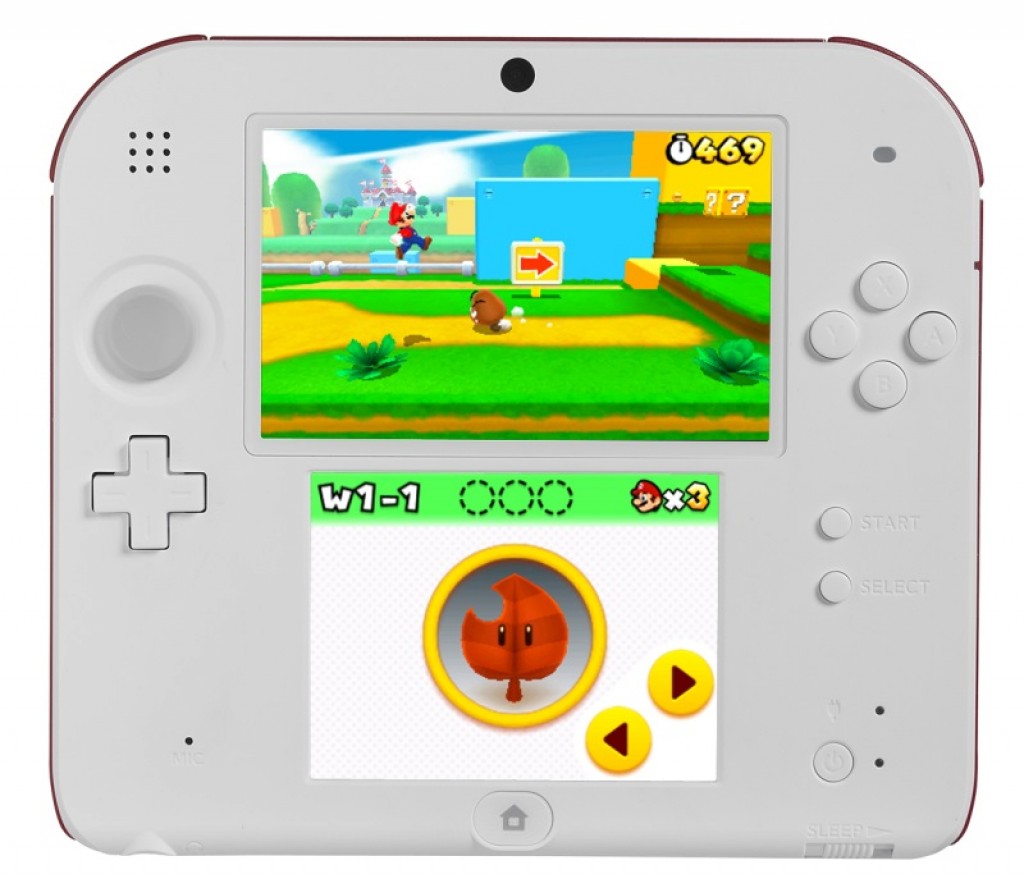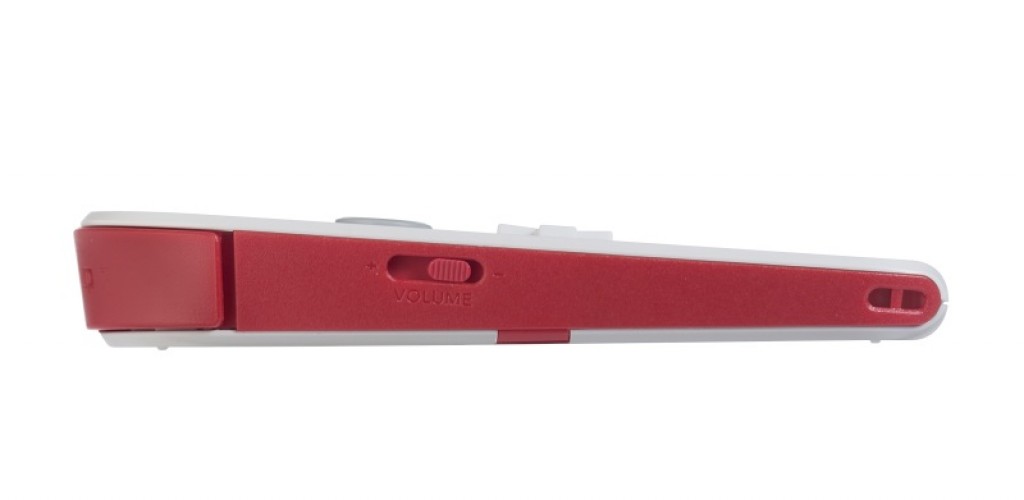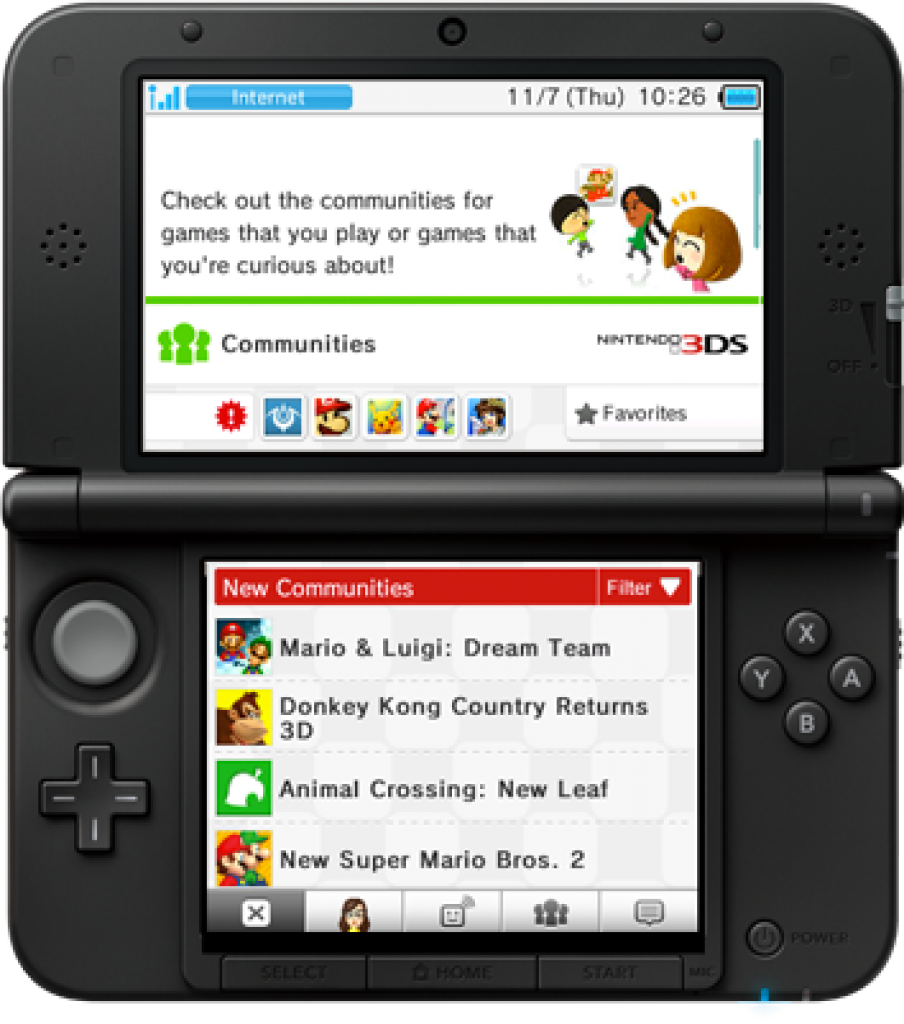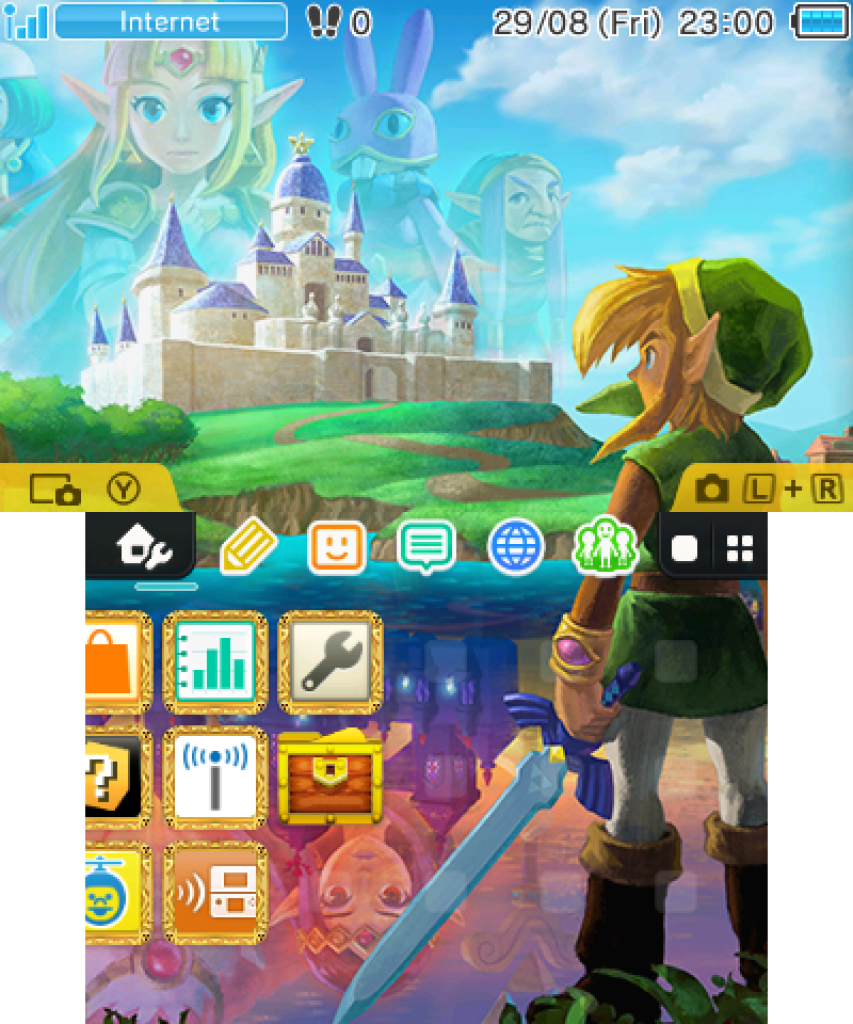
Its looks and loss of 3D may be divisive, but the Nintendo 2DS console is great for kids and it’s now cheaper than ever
After the huge success of the DS Lite, a budget version of Nintendo’s popular 3DS handheld console was all but guaranteed. However, few expected it to come in the form of the 2DS. As the name suggests, the glasses-free 3D that made the 3DS so unique has been removed, letting you play 3DS games in plain old 2D.
This may seem like a step backwards, but the console’s simplified design allows it to be sold for much less, and its robust plastic chassis makes it far more suitable for younger audiences – particularly those aged six years and under who were originally warned off using the console’s glasses-free 3D due to health concerns.
Game bundles and price
The 2DS is now cheaper than ever, too, making it a great buy for your kids. Tesco is currently selling the blue and black version with Mario Kart 7 pre-installed on the console for just pounds 70. That’s an incredible bargain. You can also pick one up for pounds 80 direct from Nintendo which includes a protective case and either a copy of the quirky Tomodachi Life, or one of several Pokemon games. You’ll need to pay a bit more if you want a different console bundle, such as the pounds 85 Super Mario Bros 2 pack, or pounds 96 for Luigi’s Mansion 2, but that’s still incredible value if you don’t want to pay top price for a New 3DS or New 3DS XL.
Even better, Nintendo has just added over 100 demos to the 2DS’s online eShop store so you can try out games for free. Highlights include Super Smash Bros, Pokemon Omega Ruby and Alpha Sapphire and Nintendogs +Cats. There are also several free-to-start games available too, such as the excellent puzzle game Fullblox and Pokemon Rumble World. These games don’t cost anything to download initially, but do require in-game purchases if you want to play more of the game. Fullblox is perhaps the best example of this, as you can buy additional puzzle packs to suit your skill level or buy them all in a bundle for a slightly lower cost than buying them individually. If you’re an avid puzzle fan, it’s well worth a look.
over 100 demos to the 2DS’s online eShop store so you can try out games for free. Highlights include Super Smash Bros, Pokemon Omega Ruby and Alpha Sapphire and Nintendogs +Cats. There are also several free-to-start games available too, such as the excellent puzzle game Fullblox and Pokemon Rumble World. These games don’t cost anything to download initially, but do require in-game purchases if you want to play more of the game. Fullblox is perhaps the best example of this, as you can buy additional puzzle packs to suit your skill level or buy them all in a bundle for a slightly lower cost than buying them individually. If you’re an avid puzzle fan, it’s well worth a look.
Design
The loss of the clamshell hinge will come as a blow to fans of the original 3DS design, but its new wedge shape is surprisingly comfortable to hold. The bottom corners sit snugly in the centre of your palms and the Circle Pad and ABXY buttons are perfectly positioned to lie directly underneath your thumb. Likewise, the trigger buttons are now much easier to reach than before as they lie more naturally underneath your index fingers compared to the cramp-inducing shape of the original 3DS.
Admittedly, the matt plastic chassis is a far cry from the sleek contours of Nintendo’s previous budget handheld, the gorgeous DS Lite, but it’s far more suited to being thrown around in a backpack than other members of the 3DS family. We always thought the 3DS was a little fragile to carry around in our bag without a case, but we have no such qualms about the 2DS’s tough exterior.
Screens
The top screen is also protected by a tough plastic cover that sits flush to the console. The only vulnerable part of the 2DS then is the lower touchscreen. This has to be left exposed in order to use it, but special cases are available (pounds 10 from Amazon) if you’re worried about it getting scratched. Losing the clamshell also means there’s no lid to automatically put the console into sleep mode, so Nintendo’s included a new slider on the bottom right corner of the console to turn the screens off if you have to stop mid-game. It doesn’t quite match the convenience of snapping the lid shut on the 3DS, but it’s a decent work-around.
Otherwise, the 2DS is very similar to its 3D counterparts. It has the same screen dimensions and resolution as the original 3DS (800×240 on the top 3.53in screen and 320×240 on the lower 3in touchscreen), so games play exactly the same on each one, and it’s backwards compatible with Nintendo’s entire DS catalogue as well.
With no hinge to get in the way, there’s now a smaller gap between the two displays; plus the Circle Pad, D-pad and ABXY buttons have all been elevated to the centre of the console. The Start and Select buttons now have their own dedicated buttons as well on the right hand side above the power button, while the Home button remains in the centre along the bottom. Sadly, the 2DS only has one speaker compared to the stereo speakers found on the 3DS and 3DS XL, but you can still get stereo sound by plugging in a pair of headphones.
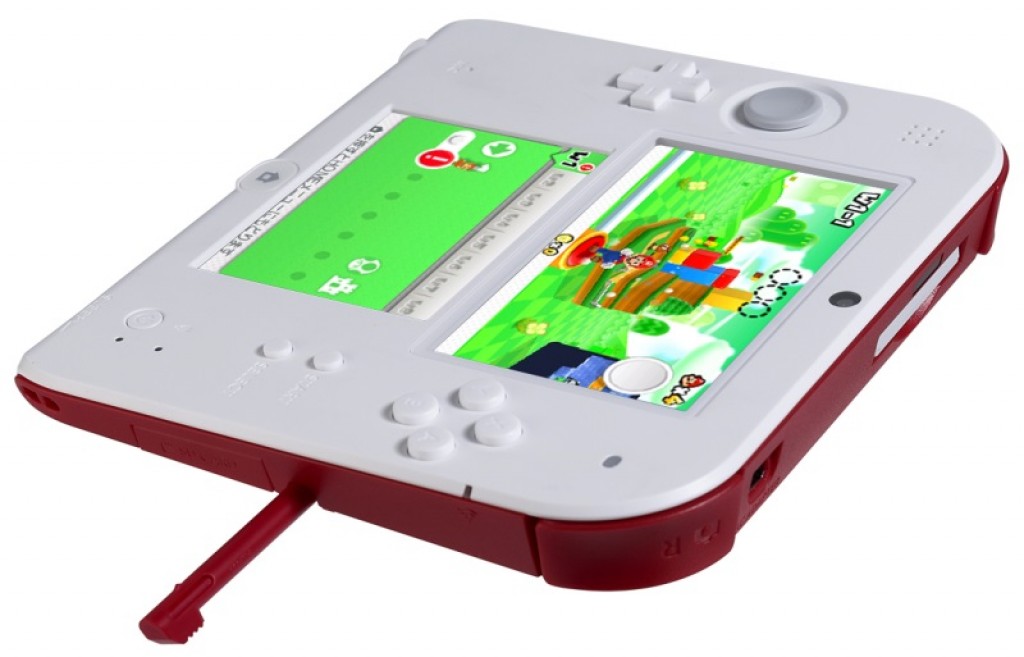
The stylus is located to the right, mirroring its position on the 3DS XL. It’s a little slimmer and taller than the 3DS XL stylus, making it a little easier and more comfortable to hold, but it doesn’t quite match the full height of the extending 3DS stylus.
Camera
Oddly, the 2DS still has the 3DS’s twin 0.3 megapixel cameras on the outside of the lid. This means you can still take 3D photos, but you’ll only be able to view them in 3D if you export them to another 3DS or 3DS XL. The camera on the inside of the 2DS hasn’t changed either, so you can still take amusing self-portraits and doodle on them afterwards.
The built-in gyroscopes come into their own on the 2DS, as there’s no stereoscopic 3D sweet-spot to worry about on the top screen. We didn’t have to move our head along with the console when games like the pre-installed Face Raiders required us to look around our environment, and its viewing angles were excellent. It’s still quite reflective to look at in direct sunlight, but it’s no worse than an ordinary 3DS.
With no 3D to drain the battery life you’ll also be able to play your games for longer between charges, this is due to the increased screen brightness required for the 3D effect. We managed just over five hours of continuous play in Pokemon Y, but games that involve heavy use of the touchscreen will drain it faster. Sadly, the 2DS doesn’t come with a charging cradle like the original 3DS, but at least there’s a power adapter included in the box. Bizarrely, 3DS XL owners had to buy this separately for around pounds 7.
Wi-Fi, Miiverse, Streetpass and Spotpass
Like the 3DS before it, the 2DS has built-in wireless, allowing you to play multiplayer games locally and online. There’s also a web browser available on the main home screen, which you can jump into any time, even when you’re in the middle of playing a game. It’s not particularly fast, but it’s quite handy to have on hand if you want to quickly look something up while playing a game.
The Wii U’s Miiverse feature has also been added to Nintendo’s handheld consoles. Provided you have a Nintendo Network ID (which you’ll need if you want to buy any digital titles from the Nintendo eShop), Miiverse is Nintendo’s Twitter-esque social network which lets you share screenshots and comments with other players around the world. Each community is tied to a specific game, but you can star your favourites so you don’t lose track of them. We don’t think the 2DS (or 3DS)’s small screens work quite as well in Miiverse as the Wii U’s GamePad, but the ability to draw your own doodles using the stylus instead of simply typing out comments is still one of our favourite features.
The main reason why you’ll want to leave wireless communications on, though, is for the 2DS’s Streetpass and Spotpass features. Spotpass will automatically download new content when you connect to a wireless hotspot, such as new Nintendo Direct announcements, eShop offers or exclusive in-game content. Streetpass, on the other hand, will detect other 2DS and 3DS consoles when the console’s in sleep mode and exchange information with other players. This ranges from Mii avatars which go on to populate your Mii Plaza to game-specific Streetpass content such as special items and ghost race track times from Mario Kart. A small light above the ABXY buttons will notify you when you’ve exchanged information, but you can always disable the wireless communication in the System Settings if you prefer.
Home Themes
If you don’t like the 2DS’s grey and white default home menu, you can now buy and download other Nintendo-themed home menus from the special home eShop menu. Just tap the new settings button in the top left corner of the home screen and hit ‘change theme’ and you’ll be presented with a huge array of different colours and specially-designed game wallpapers. There are a couple of free ones available, but most you’ll have to buy – although at pounds 1.79 for the most, so they’ll hardly break the bank.
Source: expertreviews.co.uk

